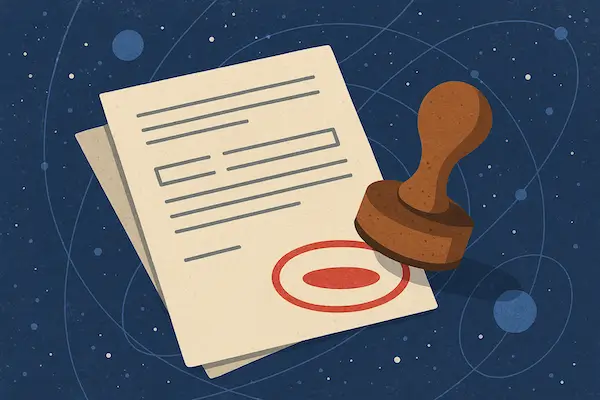Introduction to the CNRS, What Is It and What Does it Do?
One possibility to get a permanent position in astronomy in France is to work as a Chargé de recherche at the CNRS, but what is the CNRS ? What’s its status, its structure, its relation to researchers? Let’s try to make it less blurry to all of us and summarize the role the CNRS has in French public research.
Missions, Structure and History of the CNRS
The Centre National de la Recherche Scientifique (National Center for Scientific Research, CNRS) is the only institution in France managing scientific activities in all scientific domains. Their main mission is to support all kind of scientific research from three different aspects:
- Research in various domains, gathering experts from all disciplines and promoting multidisciplinarity.
- Innovation of certain research projects which can lead to the creation of new technologies improving our society.
- Scientific communication, promoting an open science and outreach for a broad scientific culture.
The president-director of the CNRS is named by the Conseil des Ministres (Council of ministers), under the suggestion of the Ministère de l’Enseignement supérieur et de la Recherche (Ministry for Higher Education and Research). Since 2018, the president-director is Antoine Petit, professor of mathematics and doctor in computer science.
The CNRS was created in October 1939 with the goal to coordinate the scientific activities of the different laboratories in France. After the Second World War, the CNRS becomes mainly focused on fundamental research. In 1966, laboratories partially affiliated to the CNRS are created (future Unités Mixtes de Recherche, UMR, see the different tutelles explained in the blog post Working as an Astronomer in France), which leads to the creation of the first National Institutes in 1967. Since then, the CNRS is sub-divided in so-called Instituts Nationaux (IN), gathering the affiliated laboratories by topics. Nowadays, the CNRS is divided in 10 National Institutes, listed here:
| Acronym | Field |
|---|---|
| INSB | Biology |
| INC | Chemistry |
| INS2I | Computer sciences |
| INSU | Earth and Universe |
| InEE | Ecology and environment |
| INSIS | Engineering |
| InSHS | Human sciences and society |
| INSMI | Mathematics |
| IN2P3 | Nuclear physics and particles |
| INP | Physics |
Each National Institute is then spread over different sections that precise a bit more their broad global theme. For example, the National Institute affiliated to research in astronomy is INSU: Institut National des Sciences de l’Univers (National Institute of the Sciences of the Universe). It is distributed over 4 sections which are:
- Section 17 - Solar System and distant universe
- Section 18 - Earth and the Terrestrial Planets: structure, history and models
- Section 19 - The Earth System: superficial layers
- Section 30 - Continental Surface and Interfaces (shared with InEE)
For more details on the distribution of the sections among the different National Institutes, please check here: https://www.cnrs.fr/comitenational/english/intitsec.htm. However, this will change in September 2025: the CNRS decided to reorganize the different sections, motivated by the creation of two new sections. This decision results from an important evolution of the research in the domain of physics of complex matter and life. In short, the old Section 17 is becoming the new Section 19. You can find the new definitions of the sections in the table here: https://www.cnrs.fr/comitenational/Actualites/RenouvellementSection2529/Sections-Mandat-2025-2029.pdf.
There is something unique to the INSU compared to the others National Institutes: it is sub-divided in multiple OSU: Observatoires des Sciences de l’Univers (Observatories of the Sciences of the Universe). However, we will detail this aspect more in the presentation of the CNAP as the OSU are highly involved in the community service, which is a task specific to the CNAP Astronome-adjoint position.
To summarize, each laboratory or observatory in France affiliated to the CNRS is linked to a National Institute (directly or through their OSU) and then, researchers are spread over the different sections.
How does the CNRS support research in France?
Now that we know the global structure of the CNRS, how does it technically work? The CNRS has an annual budget which is voted by the CNRS Conseil d’administration (administrative council: https://www.cnrs.fr/en/the-cnrs/the-board-of-trustees). The main part of the budget goes towards hiring (we’ll talk a bit more about this right below), but it can also financially support some specific projects (e.g., in 2020, the budget was distributed as listed here: https://www.cnrs.fr/fr/actualite/cnrs-un-budget-en-hausse-de-130-meu-et-de-10-en-moyenne-pour-les-dotations-aux).
It is worth noting that the CNRS also allocates part of its budget to distinctions and awards in order to promote “excellent” research in the different French laboratories. In the following, you can find a list of the different CNRS awards: https://www.cnrs.fr/en/the-cnrs/distinctions.
Careers at the CNRS: More Than Just Researcher Positions
In order to better manage the global scientific direction of the country, the CNRS will provide different permanent positions in the laboratories. The most obvious one is the researcher position, but the CNRS also hires engineers, technicians, infrastructure managers etc… In astronomy, the CNRS mostly hires researchers, engineers and technicians in instrumentation and computer science, but these are not the only options. If you are interested in any of them, we advise to regularly look at the CNRS career portal where different offers appear regularly: https://emploi.cnrs.fr/Recherche.aspx. If you’re primarily interested in exploring various opportunities and reviewing examples, we recommend browsing through their career website: https://carrieres.cnrs.fr/en/.
In general, researcher positions and some engineers and technicians are accessible via a concours process, but a whole other slew of positions are available through their job announcements as well.
Understanding the concours
The concours (literally “competition”) is a nation-wide hiring process where non-permanent researchers can get a permanent position by suggesting a science project for the long term in a laboratory of their choice. Each year, when the CNRS Conseil d’administration allocates its budget, it decides on how many people they want to hire. These positions are then distributed over the different National Institutes that we talked about earlier, and the different sections. In the Section 17, the current astronomy and astrophysics section, on average we have 4-6 positions open each year, nation-wide.
During this concours, a committee will judge the different candidates based on the following criteria, as mentioned on the website of the Section 17:
- the quality of their scientific production and the scope of their results, as well as their capacity to pursue innovative and quality research;
- their autonomy, long-term vision, and perspective on their research field;
- the scientific relevance of the research project, and the positioning of this project in the proposed host laboratory and the French scientific landscape more generally.
This means that the candidates suggest their own research project in the laboratory of their choice. Having the support of the local laboratory can be a plus (we will talk about this in more details in another blog post) but does not guarantee a permanent position as the concours is nation-wide and only depends on the committee’s decisions.
The details of how the concours works with all the deadlines and advice are reserved for another blog post. What we want to emphasize is that the number of positions available in the Section 17 depends on the decision of the Conseil administratif regarding the total number of positions allocated in one specific year, which is then distributed among the different National Institutes, and then sections. The number of positions is usually known by the opening of the concours.
Relation to Other French Permanent Research Positions
As a reminder, the other junior French permanent research positions are the Astronome-Adjoint with CNAP and Maître de Conférence with CNU. Both of these positions have mandatory duties beyond their research time (teaching and community service for the first one) while the CNRS Chargé de Recherche (junior researcher) has 100% of their time nominally allocated to their research. For all the permanent positions, other tasks are to be taken into account on top of the different mandatory duties (e.g., administration, mentoring, involvement in committees, etc…). The distribution between these often unmentioned tasks and the mandatory duties can differ between the CNRS permanent positions and the others.
Links:
- CNRS: https://www.cnrs.fr/en
- INSU: https://www.insu.cnrs.fr/fr/les-observatoires-des-sciences-de-lunivers-0
- CNRS history: https://fr.wikipedia.org/wiki/Centre_national_de_la_recherche_scientifique
- CNRS concours for researchers: https://carrieres.cnrs.fr/concours-externes-des-chercheurs-h-f/
- CNRS concours for engineers and technicians: https://carrieres.cnrs.fr/concours-externes-des-ingenieurs-et-techniciens-h-f/
- Change in Section distribution: https://www.cnrs.fr/fr/actualite/evolution-des-perimetres-des-sections-du-comite-national-de-la-recherche-scientifique



